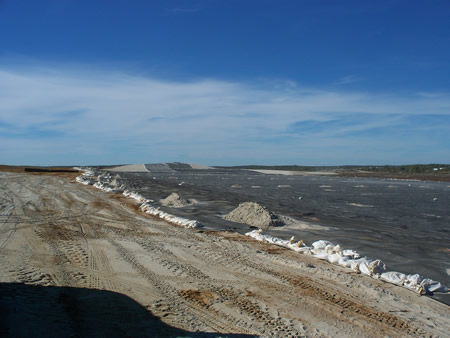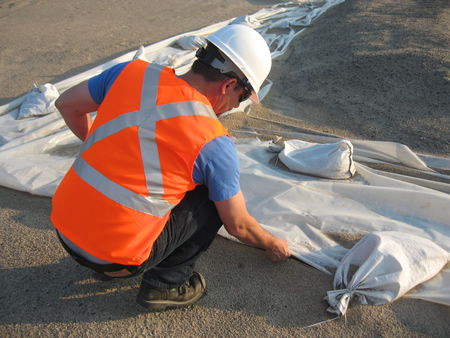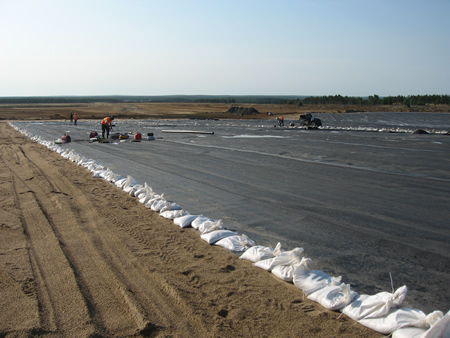



 Mining is a vital activity for modern life. The metals, minerals, and other raw materials extracted enable the production and success of many (if not most) of the goods each of us utilizes directly and indirectly on a daily basis for communication, transportation, food production, safety, etc. But the legacy of mining, particularly for mines that were initiated before the advent of today’s containment materials, such as geosynthetic barriers, can present very difficult environmental challenges.
Mining is a vital activity for modern life. The metals, minerals, and other raw materials extracted enable the production and success of many (if not most) of the goods each of us utilizes directly and indirectly on a daily basis for communication, transportation, food production, safety, etc. But the legacy of mining, particularly for mines that were initiated before the advent of today’s containment materials, such as geosynthetic barriers, can present very difficult environmental challenges.
The remediation of Lynn Lake, Manitoba’s Farley Mine provides an exemplary case for how geosynthetic systems are being used in larger geotechnical work to properly cap old mines.
FARLEY MINE’S HISTORY
Originally developed as a nickel mine, the Farley Mine began production in 1953 and deposited tailings in an unlined zone now referred to as the East Tailings Management Area (ETMA). After 1976, the nickel operation was expanded with the mill also producing at various times zinc, copper, and gold. This went on under the management of multiple operators until 2002 when mining operations ceased as the province of Manitoba entered into a number of site environmental analyses.
The former tailings cells and area soils and groundwater were evaluated from 2001 to 2006, after which, in coordination with the mining firm Viridian, Inc. (a subsidiary of Agrium Corp), a remediation scheme, including funding, was developed for proper closure of the ETMA land.
The rehabilitation of the ETMA has been directed by the Province of Manitoba’s Orphaned/Abandoned Mine Site Rehabilitation Program. Launched in 2000, the program has to date identified 149 former mine sites as orphaned or abandoned. Five of these sites have been listed as “high-priority.” The former Farley Mine site in Lynn Lake is one of those five.
CLOSURE OF FARLEY MINE
Farley’s tailings are not insignificant. More than 550 acres of tailings (totaling 25 million tons) have been identified for rehabilitation, with an overall investment of CAD $25 – $60 million needed through 2016 (roughly divided 50/50 between the province and the mining company).
Major geotechnical and environmental engineering work includes:
- Construction of a rainwater and melt water diversion ditch around the ETMA (completed)
- Installation of a trial permeable reactive barrier to treat contaminated groundwater (completed)
- Revegetation trials (completed)
- A review of options for covering the tailings
- Installation of an engineered wetland to remove contaminants from the ETMA runoff (ongoing)
At the time of the award, the Farley Mine site design and installation was the largest capping project in Canada.
CAPPING THE SITE
One of the primary purposes of an engineered capping system is to prevent rainwater incursion to the polluted soil zone. Infiltration can lead to contaminated water, which subsequently can seep into groundwater or run off into area streams and lakes, thus contaminating water sources too. Soil-only caps are permeable to liquid and subject to erosion. Clay-only caps can crack and create channels for infiltration and polluted runoff.
Because of this, geotechnical engineers incorporate geosynthetic technologies in a capping system to greatly improve the barrier properties, provide long-term security, and reduce the required thickness of the system (which also reduces cost, heavy truck and equipment usage/pollution, and site labor time).
The engineering firm Arcadis provided a multi-layer design for containing the site’s polluted soils that included the installation of geomembrane, geosynthetic clay liner (GCL), and geotextile. This combination of materials provides a strong barrier to liquids (via the geomembrane and GCL) and secure defense against potential punctures in the system (as the high-swelling bentonite clay within the GCL “self-seals” when hydrated).
The geotextile provides protection for the geomembrane and provides filtration and soil separation characteristics within the cap and additional frictional strength, such as for slope security.
To execute construction of the cap’s geosynthetic layers, the general contractor Hazco (Tervita) worked closely with an International Association of Geosynthetic Installers (IAGI) certified installation company, Titan Environmental Containment.
IAGI is a third-party industry group that has established standards for experience and quality work, the value of which should not be overlooked.
Geosynthetic installations, particularly when they involve barrier systems, are often sensitive. Each product is engineered to perform specific functions and care must be taken to ensure that the products are handled and installed in a manner that ensures they begin the project in the condition they are manufactured so that they can perform their designed role at a high, unimpaired level. In the case of geomembranes, this is vitally important. Geomembranes provide an exceptional barrier against liquid migration. They must not be damaged—or if damaged, left unrepaired—during installation; to ignore safe and experienced handling may lead to leakage in the system, risk failure, and require expensive corrective action.
The seams between the geomembrane panels must also be tight to prevent leakage. High-density polyethylene (HDPE) geomembranes, such as used in Lynn Lake, are renowned for their durability in aggressive environments and long-term performance. HDPE is the most common membrane used in critical waste management and highly sensitive applications. However, HDPE is a more rigid geomembrane, which means its panels must be welded in the field rather than pre-fabricated into large flexible panels in the controlled environment of a factory. Because of this, HDPE welders should be vetted for experience because small errors in seaming even on very large installations can lead to difficult (and very expensive to correct) problems.
Titan’s team installed 749,000 m2 of 60-mil textured HDPE from GSE Environmental and 720,000 ft.2 of BENTOMAT® CL geosynthetic clay liner from CETCO. In addition to the geomembrane’s heightened chemical resistance and endurance characteristics, the texturing on the geomembrane provides increased frictional resistance. And further emphasizing the site’s security concern, the GCL specified is a reinforced material consisting of a layer of sodium bentonite between two geotextiles, which are needlepunched together and laminated with a thin flexible membrane liner for additional liquid/gas barrier properties.
Bringing it all together was challenging in Lynn Lake’s remote, windy, dusty environment. With the geomembrane, great care needed to be taken to keep the seams clean during welding so that firm bonds could be achieved between the panels.
In addition to the capping work, the Province of Manitoba has constructed a new waste disposal facility for the town and is in the process of decommissioning the existing waste disposal facility at the ETMA.
**
Titan Environmental Containment specializes in the supply and installation of geomembrane liners, bolted steel tanks, and welded tanks (www.titanenviro.ca). Chris Kelsey is the editor of Geosynthetica.











